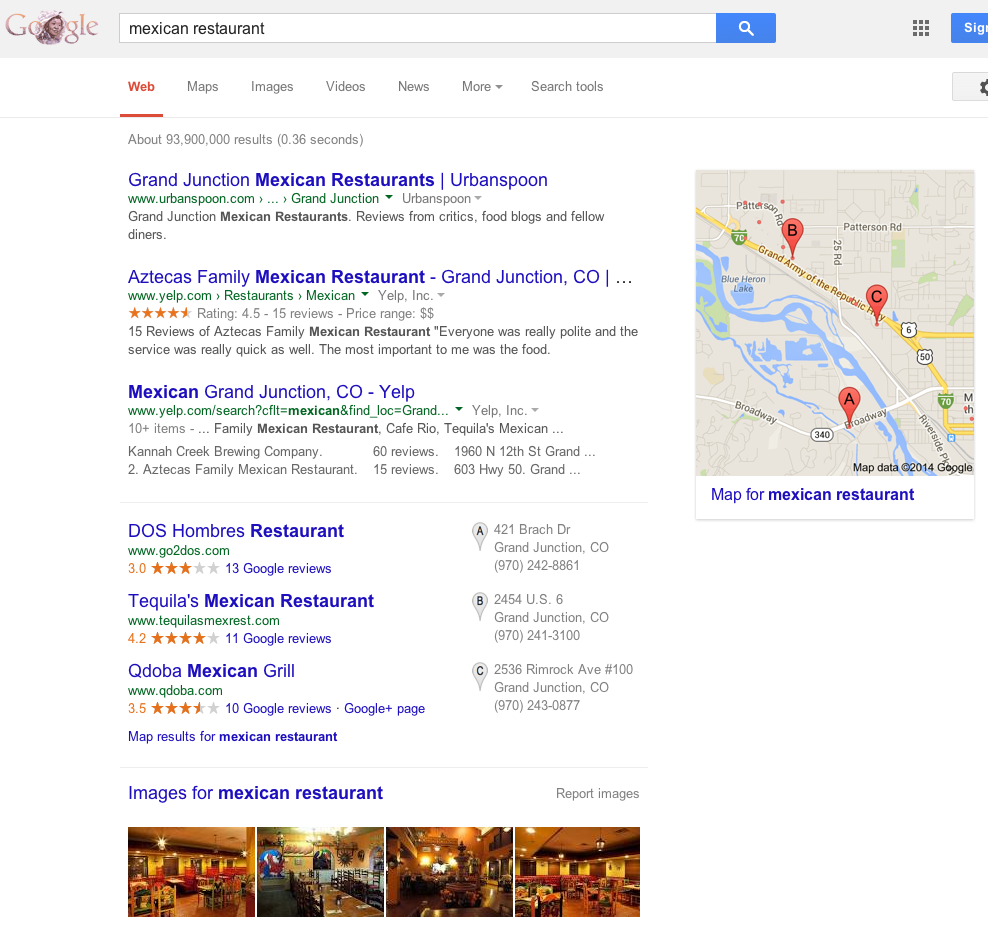Editor’s Note: This article was originally published by Web Marketing Today. Practical Ecommerce acquired Web Marketing Today in 2012. In 2016, we merged the two sites, leaving Practical Ecommerce as the successor.
“Hyperlocal” refers to a specific consumer audience in a very small geographical area. By using hyperlocal ads, your business can promote products and services to a local audience in your immediate surroundings.
Since 2008, Google’s search results have shown maps and map listings (i.e., local business listings). Local searchers no longer have to add a city and state as part of their search terms. The search engines know the locale of the person searching from the computer’s IP address. Based on that locale, search engines will display local results first, before national. Websites identifying themselves for a specific geography will be included in the local results. Here’s an example of Google search results for “mexican restaurant” — from a computer in Grand Junction, Colo.
For many products and for many consumers, “all business is local.” This phrase applies not to just brick-and-mortar stores, but to local websites as well. Consumers use the web to research and make a purchase. They often prefer buying from local businesses, even if those businesses are online only.
Regardless, for brick-and-mortar and online businesses, hyperlocal advertising can focus on cities, neighborhoods, and even sections in neighborhoods.
This article will address the hyperlocal advertising trend.
Hyperlocal via Google AdWords Express
Google AdWords Express offers businesses a way to reach consumers, in a business’s immediate area, that are searching for products or services.
AdWords Express ads show up next to the organic search results on desktop and mobile. The ads appear based on the searcher’s location and his search terms. AdWords Express is essentially hyperlocal advertising. You can reach your immediate community and other communities beyond your local business listings, such as a city that is, say, 100 miles from your own.
Hyperlocal via Other Websites
Beyond using Google AdWords Express, there are many local, community-based sites to consider. Here are three examples.
- Patch.com. Patch is an Internet-based town hall, reporting everything in your area from local government to weekend events. It also offers listings to restaurants, services, shops, and businesses. Patch prides itself on covering topics that matter to residents, making the content more about community news. Patch is a good way to find out about what is going on and how you can get involved. Local citizens can post pictures, events, and share their opinions.
Patch is owned jointly by AOL and Hale Global (the majority owner), which hopes to achieve profitability after AOL built it to over 900 locations nationwide since 2007. Hale Global reportedly plans to redesign for mobile and social media users, and advertisers will have “self-service” tools for creating their hyperlocal ads.
- Examiner.com. When it started in 2008, Examiner.com aimed to replace the newspapers in the local online markets. It is now a major news and lifestyle network powered by local contributors. The content is based on location. When users arrive at the site, they are automatically routed to the nearest Examiner city. Examiner’s content is created by locals and consumed by locals.
- Tribeca Citizen. In 2009, Erik Torkells started TribecaCitizen.com for the Tribeca area of New York City. Tribeca Citizen is a good example of a hyperlocal website that provides news and information for residents of the Tribeca neighborhood. The publication answers questions about shops, restaurants, real estate, and more.
“It’s hard for me to distill my thoughts on hyperlocal down to a quote, but I will say that the challenge, for me anyway, has not been reaching or engaging readers, who have proven to be hungry for hyperlocal information,” comments Torkells. “What takes up far more time and energy these days is explaining online advertising to local business owners, who do not have much experience with the Internet or bandwidth to deal with one more person asking for their time and money.
While Torkells states that “larger companies [advertisers] don’t value the hyperlocal audience the way a local business does,” I suspect that will change at some point, and large, nationwide companies will adopt hyperlocal advertising strategies, too.
Benefits of Hyperlocal Advertising
For businesses that seek local customers, hyperlocal advertising has the following benefits.
- Lower cost with higher quality. Hyperlocal advertising tends to cost less because it targets a smaller audience. An effective Google AdWords campaign typically requires a budget of at least $100 per day. However, a Google AdWords Express campaign can be achieved for as little as $20 per day and the quality of the website visitors will be much better compared to a broader audience.
- Enhanced local audience targeting. Hyperlocal advertising has greater control over the audience. This allows you to create highly specialized, local ad messages.
- New customer acquisition. Hyperlocal ads have a better chance of reaching new consumers in your area, versus nationwide ads. These new shoppers can help create repeat sales as you share commonality.
There are many ways local businesses can benefit from pay-per-click search ads. I’ve addressed that topic previously, in “5 Reasons to Use PPC Ads for Local Marketing.”






